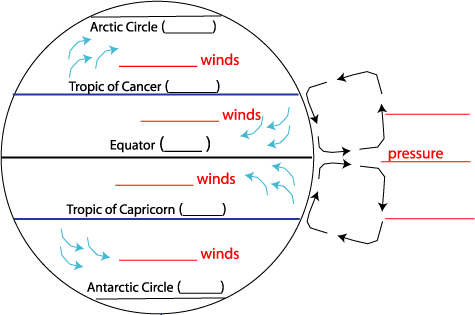4.5: Atmospheric Patterns of Motion
- Page ID
- 2254
In an ideal earth (from an atmospheric motion standpoint), there would be a uniform surface and no seasonal change. Recall the Hadley cell from the previous section. The Hadley cell is a model for the more complex pattern of global circulation. Conduct some research and see if you can label the red blanks in the figure below:

The jet stream is a narrow zone of particularly high speed winds (up to 350 - 450 km/hr) located between the tropopause and the stratosphere. The jet stream flows west to east and plays an important role in the weather. You can look at the jet stream and wind velocities over the United States at various altitudes at the Weather Channel web site.
Besides global circulation, there are winds of local importance. The 4 major types of such winds are:
- Land and sea breezes. These result from differential heating/cooling of shore vs. water and a movement of air from high to low pressure.
- Valley and mountain breezes - these are governed by the same principle as land and sea breezes. In the daytime, mountain slopes heat up creating rising air and low pressure. At night slopes cool down quickly creating cold falling air over the high mountains, and a high pressure system which causes wind to blow into the valley.
- Drainage winds (katabatic winds) - air from cold upland areas moves down into lower elevations under the influence of gravity. Off the ice sheets of Greenland and Antarctica, or down the Rhone valley (southern France).
- Foehn/Chinook winds - winds that passed over mountains and descend on the leeward side.


